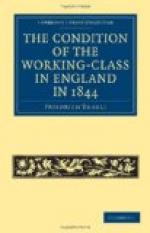factory chimneys. A horde of ragged women and
children swarm about here, as filthy as the swine that
thrive upon the garbage heaps and in the puddles.
In short, the whole rookery furnishes such a hateful
and repulsive spectacle as can hardly be equalled
in the worst court on the Irk. The race that
lives in these ruinous cottages, behind broken windows,
mended with oilskin, sprung doors, and rotten door-posts,
or in dark, wet cellars, in measureless filth and
stench, in this atmosphere penned in as if with a purpose,
this race must really have reached the lowest stage
of humanity. This is the impression and the
line of thought which the exterior of this district
forces upon the beholder. But what must one think
when he hears that in each of these pens, containing
at most two rooms, a garret and perhaps a cellar,
on the average twenty human beings live; that in the
whole region, for each one hundred and twenty persons,
one usually inaccessible privy is provided; and that
in spite of all the preachings of the physicians,
in spite of the excitement into which the cholera epidemic
plunged the sanitary police by reason of the condition
of Little Ireland, in spite of everything, in this
year of grace 1844, it is in almost the same state
as in 1831! Dr. Kay asserts that not only the
cellars but the first floors of all the houses in
this district are damp; that a number of cellars once
filled up with earth have now been emptied and are
occupied once more by Irish people; that in one cellar
the water constantly wells up through a hole stopped
with clay, the cellar lying below the river level,
so that its occupant, a hand-loom weaver, had to bale
out the water from his dwelling every morning and pour
it into the street!
Farther down, on the left side of the Medlock, lies
Hulme, which, properly speaking, is one great working-people’s
district, the condition of which coincides almost
exactly with that of Ancoats; the more thickly built-up
regions chiefly bad and approaching ruin, the less
populous of more modern structure, but generally sunk
in filth. On the other side of the Medlock,
in Manchester proper, lies a second great working-men’s
district which stretches on both sides of Deansgate
as far as the business quarter, and in certain parts
rivals the Old Town. Especially in the immediate
vicinity of the business quarter, between Bridge and
Quay Streets, Princess and Peter Streets, the crowded
construction exceeds in places the narrowest courts
of the Old Town. Here are long, narrow lanes
between which run contracted, crooked courts and passages,
the entrances to which are so irregular that the explorer
is caught in a blind alley at every few steps, or
comes out where he least expects to, unless he knows
every court and every alley exactly and separately.
According to Dr. Kay, the most demoralised class of
all Manchester lived in these ruinous and filthy districts,
people whose occupations are thieving and prostitution;
and, to all appearance, his assertion is still true
at the present moment. When the sanitary police
made its expedition hither in 1831, it found the uncleanness
as great as in Little Ireland or along the Irk (that
it is not much better to-day, I can testify); and
among other items, they found in Parliament Street
for three hundred and eighty persons, and in Parliament
Passage for thirty thickly populated houses, but a
single privy.




